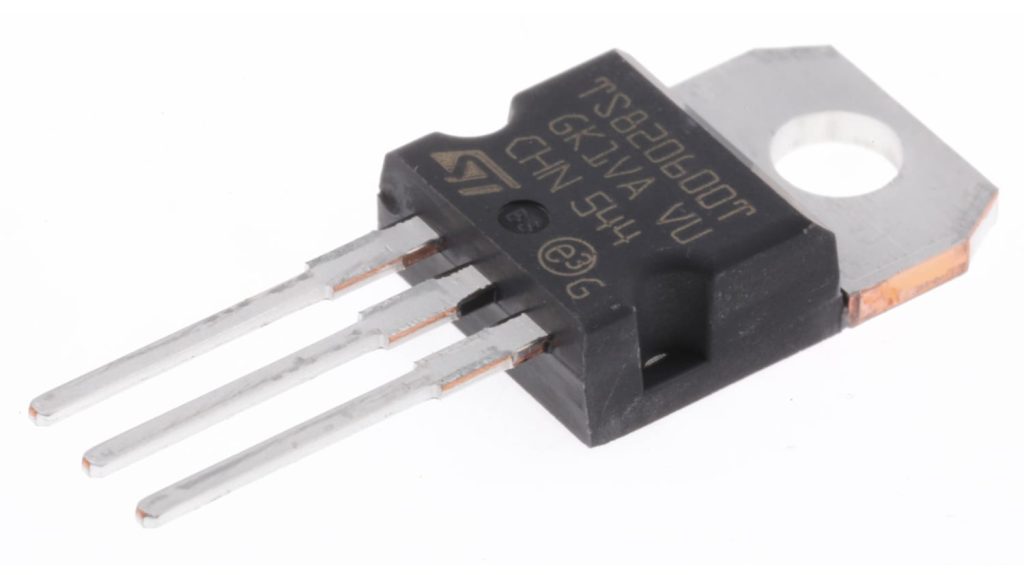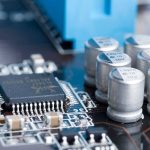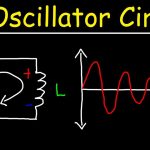In many ways the Silicon Controlled Rectifier, SCR or just Thyristor as it is more commonly known, is similar in construction to the transistor
It is a multi-layer semiconductor device, hence the “silicon” part of its name. It requires a gate signal to turn it “ON”, the “controlled” part of the name and once “ON” it behaves like a rectifying diode, the “rectifier” part of the name. In fact the circuit symbol for the thyristor suggests that this device acts like a controlled rectifying diode.

Thyristor Symbol
However, unlike the junction diode which is a two layer ( P-N ) semiconductor device, or the commonly used bipolar transistor which is a three layer ( P-N-P, or N-P-N ) switching device, the Thyristor is a four layer ( P-N-P-N ) semiconductor device that contains three PN junctions in series, and is represented by the symbol as shown.
Like the diode, the Thyristor is a unidirectional device, that is it will only conduct current in one direction only, but unlike a diode, the thyristor can be made to operate as either an open-circuit switch or as a rectifying diode depending upon how the thyristors gate is triggered. In other words, thyristors can operate only in the switching mode and cannot be used for amplification.
The silicon controlled rectifier SCR, is one of several power semiconductor devices along with Triacs (Triode AC’s), Diacs (Diode AC’s) and UJT’s (Unijunction Transistor) that are all capable of acting like very fast solid state AC switches for controlling large AC voltages and currents. So for the Electronics student this makes these very handy solid state devices for controlling AC motors, lamps and for phase control.
The thyristor is a three-terminal device labelled: “Anode”, “Cathode” and “Gate” and consisting of three PN junctions which can be switched “ON” and “OFF” at an extremely fast rate, or it can be switched “ON” for variable lengths of time during half cycles to deliver a selected amount of power to a load. The operation of the thyristor can be best explained by assuming it to be made up of two transistors connected back-to-back as a pair of complementary regenerative switches as shown.
A Thyristors Two Transistor Analogy

The two transistor equivalent circuit shows that the collector current of the NPN transistor TR2 feeds directly into the base of the PNP transistor TR1, while the collector current of TR1 feeds into the base of TR2. These two inter-connected transistors rely upon each other for conduction as each transistor gets its base-emitter current from the other’s collector-emitter current. So until one of the transistors is given some base current nothing can happen even if an Anode-to-Cathode voltage is present.
When the thyristors Anode terminal is negative with respect to the Cathode, the centre N-P junction is forward biased, but the two outer P-N junctions are reversed biased and it behaves very much like an ordinary diode. Therefore a thyristor blocks the flow of reverse current until at some high voltage level the breakdown voltage point of the two outer junctions is exceeded and the thyristor conducts without the application of a Gate signal.
This is an important negative characteristic of the thyristor, as Thyristors can be unintentionally triggered into conduction by a reverse over-voltage as well as high temperature or a rapidly rising dv/dt voltage such as a spike.
If the Anode terminal is made positive with respect to the Cathode, the two outer P-N junctions are now forward biased but the centre N-P junction is reverse biased. Therefore forward current is also blocked. If a positive current is injected into the base of the NPN transistor TR2, the resulting collector current flows in the base of transistor TR1. This in turn causes a collector current to flow in the PNP transistor, TR1 which increases the base current of TR2 and so on.

Typical Thyristor
Very rapidly the two transistors force each other to conduct to saturation as they are connected in a regenerative feedback loop that can not stop. Once triggered into conduction, the current flowing through the device between the Anode and the Cathode is limited only by the resistance of the external circuit as the forward resistance of the device when conducting can be very low at less than 1Ω so the voltage drop across it and power loss is also low.
Then we can see that a thyristor blocks current in both directions of an AC supply in its “OFF” state and can be turned “ON” and made to act like a normal rectifying diode by the application of a positive current to the base of transistor, TR2 which for a silicon controlled rectifier is called the “Gate” terminal.
The operating voltage-current I-V characteristics curves for the operation of a Silicon Controlled Rectifier are given as:
Thyristor I-V Characteristics Curves

Once the thyristor has been turned “ON” and is passing current in the forward direction (anode positive), the gate signal looses all control due to the regenerative latching action of the two internal transistors. The application of any gate signals or pulses after regeneration is initiated will have no effect at all because the thyristor is already conducting and fully-ON.
Unlike the transistor, the SCR can not be biased to stay within some active region along a load line between its blocking and saturation states. The magnitude and duration of the gate “turn-on” pulse has little effect on the operation of the device since conduction is controlled internally. Then applying a momentary gate pulse to the device is enough to cause it to conduct and will remain permanently “ON” even if the gate signal is completely removed.
Therefore the thyristor can also be thought of as a Bistable Latch having two stable states “OFF” or “ON”. This is because with no gate signal applied, a silicon controlled rectifier blocks current in both directions of an AC waveform, and once it is triggered into conduction, the regenerative latching action means that it cannot be turned “OFF” again just by using its Gate.
So how do we turn “OFF” the thyristor?. Once the thyristor has self-latched into its “ON” state and passing a current, it can only be turned “OFF” again by either removing the supply voltage and therefore the Anode (IA) current completely, or by reducing its Anode to Cathode current by some external means (the opening of a switch for example) to below a value commonly called the “minimum holding current”, IH.
The Anode current must therefore be reduced below this minimum holding level long enough for the thyristors internally latched pn-junctions to recover their blocking state before a forward voltage is again applied to the device without it automatically self-conducting. Obviously then for a thyristor to conduct in the first place, its Anode current, which is also its load current, IL must be greater than its holding current value. That is IL > IH.
Since the thyristor has the ability to turn “OFF” whenever the Anode current is reduced below this minimum holding value, it follows then that when used on a sinusoidal AC supply the SCR will automatically turn itself “OFF” at some value near to the cross over point of each half cycle, and as we now know, will remain “OFF” until the application of the next Gate trigger pulse.
Since an AC sinusoidal voltage continually reverses in polarity from positive to negative on every half-cycle, this allows the thyristor to turn “OFF” at the 180o zero point of the positive waveform. This effect is known as “natural commutation” and is a very important characteristic of the silicon controlled rectifier.
Thyristors used in circuits fed from DC supplies, this natural commutation condition cannot occur as the DC supply voltage is continuous so some other way to turn “OFF” the thyristor must be provided at the appropriate time because once triggered it will remain conducting.
However in AC sinusoidal circuits natural commutation occurs every half cycle. Then during the positive half cycle of an AC sinusoidal waveform, the thyristor is forward biased (anode positive) and a can be triggered “ON” using a Gate signal or pulse. During the negative half cycle, the Anode becomes negative while the Cathode is positive. The thyristor is reverse biased by this voltage and cannot conduct even if a Gate signal is present.
So by applying a Gate signal at the appropriate time during the positive half of an AC waveform, the thyristor can be triggered into conduction until the end of the positive half cycle. Thus phase control (as it is called) can be used to trigger the thyristor at any point along the positive half of the AC waveform and one of the many uses of a Silicon Controlled Rectifier is in the power control of AC systems as shown.
Thyristor Phase Control

At the start of each positive half-cycle the SCR is “OFF”. On the application of the gate pulse triggers the SCR into conduction and remains fully latched “ON” for the duration of the positive cycle. If the thyristor is triggered at the beginning of the half-cycle ( θ = 0o ), the load (a lamp) will be “ON” for the full positive cycle of the AC waveform (half-wave rectified AC) at a high average voltage of 0.318 x Vp.
As the application of the gate trigger pulse increases along the half cycle ( θ = 0o to 90o ), the lamp is illuminated for less time and the average voltage delivered to the lamp will also be proportionally less reducing its brightness.
Then we can use a silicon controlled rectifier as an AC light dimmer as well as in a variety of other AC power applications such as: AC motor-speed control, temperature control systems and power regulator circuits, etc.
Thus far we have seen that a thyristor is essentially a half-wave device that conducts in only the positive half of the cycle when the Anode is positive and blocks current flow like a diode when the Anode is negative, irrespective of the Gate signal.
But there are more semiconductor devices available which come under the banner of “Thyristor” that can conduct in both directions, full-wave devices, or can be turned “OFF” by the Gate signal.
Such devices include “Gate Turn-OFF Thyristors” (GTO), “Static Induction Thyristors” (SITH), “MOS Controlled Thyristors” (MCT), “Silicon Controlled Switch” (SCS), “Triode Thyristors” (TRIAC) and “Light Activated Thyristors” (LASCR) to name a few, with all these devices available in a variety of voltage and current ratings making them attractive for use in applications at very high power levels.
Thyristor Summary
Silicon Controlled Rectifiers known commonly as Thyristors are three-junction PNPN semiconductor devices which can be regarded as two inter-connected transistors that can be used in the switching of heavy electrical loads. They can be latched-“ON” by a single pulse of positive current applied to their Gate terminal and will remain “ON” indefinitely until the Anode to Cathode current falls below their minimum latching level.
Static Characteristics of a Thyristor
· Thyristors are semiconductor devices that can operate only in the switching mode.
· Thyristor are current operated devices, a small Gate current controls a larger Anode current.
· Conducts current only when forward biased and triggering current applied to the Gate.
· The thyristor acts like a rectifying diode once it is triggered “ON”.
· Anode current must be greater than holding current to maintain conduction.
· Blocks current flow when reverse biased, no matter if Gate current is applied.
· Once triggered “ON”, will be latched “ON” conducting even when a gate current is no longer applied providing Anode current is above latching current.
Thyristors are high speed switches that can be used to replace electromechanical relays in many circuits as they have no moving parts, no contact arcing or suffer from corrosion or dirt. But in addition to simply switching large currents “ON” and “OFF”, thyristors can be made to control the mean value of an AC load current without dissipating large amounts of power. A good example of thyristor power control is in the control of electric lighting, heaters and motor speed.


